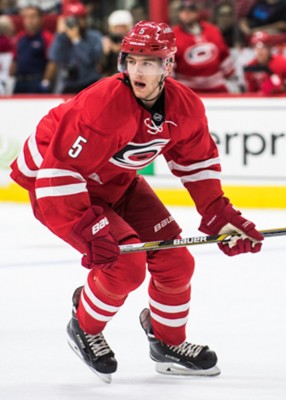
Led by Canadian sensation Connor McDavid, this year’s NHL rookie class is loaded with talent. McDavid is considered by many to be the best prospect since Pittsburgh’s Sidney Crosby. Despite suffering an injury early that sidelined him for most of his rookie campaign, he has still managed to score 24 points in his first 20 big-league games — the same number Crosby had in his first 20 games.
Aside from McDavid, though, this year’s rookie class features some top-caliber talent that come from college hockey.
Former Boston University star forward Jack Eichel (2015 Hobey Baker award winner) and former Union College defenseman Shayne Gostisbehere (2014 Hobey Baker award finalist) have manufactured excellent rookie seasons. Each has entered the conversation as a viable candidate for the Calder Memorial Trophy, which is given annual to the NHL’s best rookie.
While neither of the two is favored to win the trophy, they both perfectly exemplify not just the quantity, but the excellence of NCAA Hockey players in the NHL in recent years.
A closer look reveals that many of the NHL’s best players and leaders trace their roots to the NCAA. Jonathan Toews, captain of the Chicago Blackhawks — winners of three of the last six Stanley Cup Championships — played two years at the University of North Dakota. His teammate and alternate captain, Duncan Keith, spent one full season and a bit of a second at Michigan State University before starring for one season with the Western Hockey League’s Kelowna Rockets.
The alternate captains of the Minnesota Wild — Zach Parise and Ryan Suter — both played college hockey. Parise also played at UND and dominated during his two seasons there, scoring 116 points in 76 games. Ryan Suter played just one year of college hockey for the University of Wisconsin. The stout defenseman excelled, scoring 19 points in 39 games.
San Jose Sharks’ captain Joe Pavelski also played for Wisconsin and played a key part in the Badgers’ National Championship in 2006. That particular team sent other players to the NHL as well, most notably St. Louis Blues goaltender Brian Elliott.
St. Louis Blues captain David Backes played consistent, solid hockey for three years at Minnesota State University, Mankato. Also of the Blues, defenseman Kevin Shattenkirk played on Boston University’s 2009 National Championship team, alongside Colin Wilson (Nashville Predators) and Nick Bonino (Pittsburgh Penguins).
This list could go on even further, but the bottom line is this: in 2003, only 21 percent of NHL players came from the NCAA. In 2015, that number had risen to over 30 percent. Looking ahead, that number could continue to grow even further.
Aside from this year’s rookies, the NCAA has sent several high-profile players to the NHL in recent years. Most notably, Johnny Gaudreau, the 2014 Hobey Baker winner out of Boston College, has taken the league by storm. Although he stands at just 5-foot-9-inches and weighs less than 160 pounds, Gaudreau’s game is anything but small. He’s been an All-Star in each of his first two years, and led the Flames to an unexpected playoff bout last season.
Despite college hockey’s rapid rise, an overwhelming majority of first-round picks (and especially first overall picks) have come from either North American Major Junior Leagues or leagues overseas.
In fact, the last No. 1 overall pick to come from the NCAA was defenseman Erik Johnson out of the University of Minnesota, selected by the St. Louis Blues in 2006. For example, Steven Stamkos of the Tampa Bay Lightning played junior hockey in Canada and was drafted first overall in 2008. Nail Yakupov, the Edmonton Oilers’ 2012 first overall pick, played for the same junior team as Stamkos. The trend goes on, largely because Canada is a hotbed of hockey, but things appear to be changing.
Last year’s NHL Entry Draft may be remembered as a milestone for college hockey draftees, as three of the top 10 picks came from the NCAA. Eichel went second, Noah Hanifin from Boston College went fifth and Zach Werenski from the University of Michigan went eighth.
NHL Drafts have featured at least 60 college hockey players (either future or current) for each of the past 13 years. Additionally, professional scouts thoroughly search through unsigned college free agent lists. These two feats have led to college hockey becoming one of the largest, strongest talent providers to the NHL, surpassing Europe altogether.
Here at BU, there are tangible examples of college hockey’s increasing importance. Currently, defenseman Charlie McAvoy is a valuable selection among North American skaters for the 2016 Entry Draft. He currently skates with drafted players (who will likely be staying with the Terriers next year) such as Jordan Greenway, Jakob Forsbacka Karlsson and Doyle Somerby. Next year, BU is set to welcome an influx of talent, including forwards Kieffer Bellows and Clayton Keller, defensemen Chad Krys and Dante Fabbro and goaltender Jake Oettinger.
This is just a microcosm of college hockey’s increasing prominence. The trend holds true across many other programs, and the NHL will undoubtedly benefit down the road.











